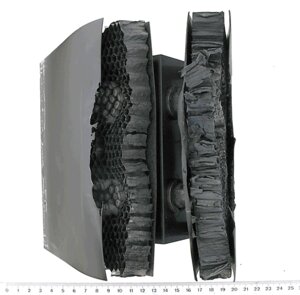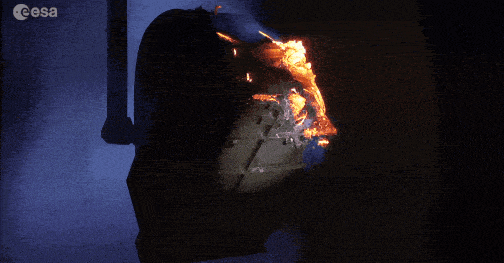Accept all cookies Accept only essential cookies See our Cookie Notice

About ESA
The European Space Agency (ESA) is Europe’s gateway to space. Its mission is to shape the development of Europe’s space capability and ensure that investment in space continues to deliver benefits to the citizens of Europe and the world.
Highlights
ESA - United space in Europe
This is ESA ESA facts Member States & Cooperating States Funding Director General Top management For Member State Delegations European vision European Space Policy ESA & EU Space Councils Responsibility & Sustainability Annual Report Calendar of meetings Corporate newsEstablishments & sites
ESA Headquarters ESA ESTEC ESA ESOC ESA ESRIN ESA EAC ESA ESAC Europe's Spaceport ESA ESEC ESA ECSAT Brussels Office Washington OfficeWorking with ESA
Business with ESA ESA Commercialisation Gateway Law at ESA Careers Cyber resilience at ESA IT at ESA Newsroom Partnerships Merchandising Licence Education Open Space Innovation Platform Integrity and Reporting Administrative Tribunal Health and SafetyMore about ESA
History ESA Historical Archives Exhibitions Publications Art & Culture ESA Merchandise Kids Diversity ESA Brand Centre ESA ChampionsLatest
Space in Member States
Find out more about space activities in our 23 Member States, and understand how ESA works together with their national agencies, institutions and organisations.
Science & Exploration
Exploring our Solar System and unlocking the secrets of the Universe
Go to topicAstronauts
Missions
Juice Euclid Webb Solar Orbiter BepiColombo Gaia ExoMars Cheops Exoplanet missions More missionsActivities
International Space Station Orion service module Gateway Concordia Caves & Pangaea BenefitsLatest
Space Safety
Protecting life and infrastructure on Earth and in orbit
Go to topicAsteroids
Asteroids and Planetary Defence Asteroid danger explained Flyeye telescope: asteroid detection Hera mission: asteroid deflection Near-Earth Object Coordination CentreSpace junk
About space debris Space debris by the numbers Space Environment Report In space refuelling, refurbishing and removingSafety from space
Clean Space ecodesign Zero Debris Technologies Space for Earth Supporting Sustainable DevelopmentApplications
Using space to benefit citizens and meet future challenges on Earth
Go to topicObserving the Earth
Observing the Earth Future EO Copernicus Meteorology Space for our climate Satellite missionsCommercialisation
ESA Commercialisation Gateway Open Space Innovation Platform Business Incubation ESA Space SolutionsLatest
Enabling & Support
Making space accessible and developing the technologies for the future
Go to topicBuilding missions
Space Engineering and Technology Test centre Laboratories Concurrent Design Facility Preparing for the future Shaping the Future Discovery and Preparation Advanced Concepts TeamSpace transportation
Space Transportation Ariane Vega Space Rider Future space transportation Boost! Europe's Spaceport Launches from Europe's Spaceport from 2012Latest

Seeing how a spacecraft dies
Thank you for liking
You have already liked this page, you can only like it once!
This simulation of ESA’s Automated Transfer Vehicle (ATV) space truck reentering Earth’s atmosphere starts by representing the surrounding of the spacecraft as a three-dimensional cloud of interconnected points, a so-called ‘computational grid’. This forms part of the process of modelling the hypersonic motion of gases around the falling spacecraft through ‘Computational Fluid Dynamics’.
This study of the ATV’s demise took place as part of the MIDGARD (MultI-Disciplinary modellinG of the Aerothemodynamically-induced fragmentation of Re-entering boDies) activity of ESA’s Open Space Innovation Platform with the University of Strathclyde’s Department of Mechanical & Aerospace Engineering. This ongoing activity aims at reducing the uncertainty on the simulation of destructive atmospheric entry by combining highly accurate but expensive and low-fidelity and fast simulation methods.
A total of five ATVs resupplied the International Space Station between 2008 and 2015, all of them disposed of by atmospheric reentry. Europe’s largest spacecraft leaves a longer-term legacy as the basis for the European Service Module of the NASA-ESA Orion spacecraft, designed to return astronauts to the Moon, and planned to fly on NASA’s first Artemis mission later this year.
Destructive atmospheric reentry is a traditional way of disposing of spacecraft and satellites at the end of their working lives, but ESA and international regulations state that the risk of injury to people or property on the ground must be lower than one in 10 000.
Fábio Morgado of the University of Strathclyde, working on MIDGARD, states: “Addressing the risk of the atmospheric reentry of space debris is progressively becoming more and more pressing due to the increase in the number of orbiting objects and the consequent higher frequency of reentry. The prediction of the reentry processes is impacted by the progressive fragmentation and thermal erosion of the re-entering objects as a result of the severe aerothermal loads.”
Prof. Marco Fossati, Principal Investigator of MIDGARD and Fabio’s supervisor, adds: “Improved modelling and simulation of the aerothermodynamically-induced fragmentation is paramount to design systems for safe demise and to assess the associated ground impact risk.”
An event in Bordeaux, France, at the end of this month will bring together experts in the ‘aerothermodynamics’ of reentry as well as ‘design for demise’ – the practice of designing space hardware to make it more likely to fully burn up in the atmosphere, rather than having any element survive down to the ground.
In the past, heavy elements such as propellant tanks or instrument optic benches have reached the ground intact, but redesigning systems to use lighter parts or making them more likely to break apart earlier in reentry can mitigate against this.
This latest Aero Thermo Dynamics & Design for Demise workshop, ATD3, is being organised by ESA with French space agency CNES with the help of the HYFAR-ARA Hypersonic Flight and Atmospheric Re-entry Association.
The ATD3 workshop will take place on 27-28 October.
-
CREDIT
University of Strathclyde -
LICENCE
ESA Standard Licence

Satellite panel following reentry testing

Testing a fiery reentry

Cluster’s Salsa satellite primed to reenter and break up

Integral reentry animation in 2029















 Germany
Germany
 Austria
Austria
 Belgium
Belgium
 Denmark
Denmark
 Spain
Spain
 Estonia
Estonia
 Finland
Finland
 France
France
 Greece
Greece
 Hungary
Hungary
 Ireland
Ireland
 Italy
Italy
 Luxembourg
Luxembourg
 Norway
Norway
 The Netherlands
The Netherlands
 Poland
Poland
 Portugal
Portugal
 Czechia
Czechia
 Romania
Romania
 United Kingdom
United Kingdom
 Slovenia
Slovenia
 Sweden
Sweden
 Switzerland
Switzerland

























